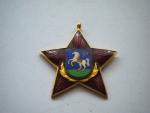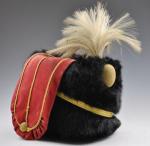-
Posts
4,862 -
Joined
-
Last visited
-
Days Won
15
Content Type
Profiles
Forums
Blogs
Gallery
Events
Store
Everything posted by peter monahan
-

RAF pilot research
peter monahan replied to jim lemon's topic in Great Britain: Militaria: Badges, Uniforms & Equipment
Interesting. I wonder what "Specialist Engineering" means. Engines or runways? Or bomb fuses? -

Prison garment?
peter monahan replied to Monsieur Hulot's topic in Great Britain: Militaria: Badges, Uniforms & Equipment
Sounds as if the consensus is 'working dress, government issue'. The galvanized iron buttons and linen suggest, to me, no later than 1930s, but I'm not a textiles/costume expert. -

4 times a Hero.....
peter monahan replied to Chris Boonzaier's topic in Great Britain: Orders, Gallantry, Campaign Medals
I copied the photo, and another I found on line, to the new unit with which I am doing WWI re-enacting: 3rd Canadian Casualty Clearing Station, staffed by Canadian nurses and stretcher bearers. Can't imagine actually going out into the trenches and No Man's Land without even the security blanklet of a pistol or rilfe! Not surprising that 2 of 3 doubel VCs were to medi al Corps types, IMHO. -

Mini 3 medal mount buckle
peter monahan replied to Noor's topic in Great Britain: Militaria: Badges, Uniforms & Equipment
So, likely silver or silver plate, privately made by Benjamin Smith for soldeiers/veterans to wear their medals on. Cool! -

Prison garment?
peter monahan replied to Monsieur Hulot's topic in Great Britain: Militaria: Badges, Uniforms & Equipment
My fairly untutored eye suggests late nineteenth, early twentieth century, by the styling but that doesn't mean much, given governments' penchants for not changing things. I assume it is wool, which again to me suggest earlier - pre-1960s anyway - rather than later, due to cost. Not sure when denim became the fatigue material of choice but I would guess sometime after WWI. Are the buttons bone, metal, rubber or plastic? Also, the brass eyelet on the trousers is odd - perhaps it came with a draw string waist rather than belt or braces? That might lend weight to the prison story, as I can't imagine any military fatigue uniform in the Commonwealth that wouldn't use braces or a belt. OTOH, the number of pockets seems odd for a prison uniform too - most have NO pockets, for obvious reasons. The long pocket on the right hip has to be for a specific object/purpose and may be a significant clue. The broad arrow was used by the Canadian military, with a 'C' around it. Not sure what our prison service used but a broad arrow is quite possible. Might also have been used by other Empire/Commonwealth countries. Interesting puzzle! Peter -
Michael It looks essentially identical to the one I owned for years, which I paid perhaps L50 for, as it was a modern reproduction and sold as such. Can't swear to the number stamp but I wouldn't be surprised if mine had had one as well. A shame that the auction house was either quite careless - no expert should have passed this as authentic - or less than honest! Sorry you were disappointed! Peter
-
Had a high school ring, acquired in Grade 13 - Ontario was the odd place out for years in having 5 years of high school instead of 4 - in Sudbury, Ontario. Silver, with a red 'stone', the school crest, modelled on that of the priests of the Order of St. Basil, who ran it, and a cardinal, our school team name. Gave it to my first university sweet heart and never got it back. But then, it probably wouldn't fit me now. Had to spend 1/2 hour getting my wedding ring off before hand surgery last month. It hadn't been off in at least a decade and I got it re-sized should the need ever arise again, though in fact I never do take it off and felt no need to until the surgeon insisted. I think the class/school ring is a nice idea. My father taught for some years at St Francis Xavier University in Nova Scotia [Canada]. "FX" grads wear a silver ring with a large blue enamel 'X' on it and can identify each other and be IDed across a room!
-
-

RAF pilot research
peter monahan replied to jim lemon's topic in Great Britain: Militaria: Badges, Uniforms & Equipment
"Equipment Branch" might well explain the commission: a pre-war technical specialist of some sort - parachute rigger, radio tech or some osuch - who was commissioned when the service expanded. It makes the DFC a bit odd though - hard to qualify for the flying gallantry award from the ground! I wonder if this uniform has been 'improved' by the addition of ribbons by some dealer [or even collector]. That seems to be coming increasingly common as a way of selling otherwise fairly common uniforms from the WWII period, helped of course by the scarcity of information on individual servicemen. -

The First World War - after 100 years - photo
peter monahan replied to yossi's topic in The Great War 1914 to 1918
Thanks for sharing, Yossi! -
Chris I work very part time for the Museums of Mississauga. Mississauga is a city of 800,000 contiguous to the city of Toronto on the west, so in Ontario, Canada, and there are about 200,000 South Asians in the city and region around it. I proposed a display on the British Indian Army's role in France in 1914-15 and my superiors allowed me to design and put on the exhibit. It features about 30 large panels of photos and text plus a few medals and shoulder titles, a kukri, a copy of a kurta which I made and some original illustrations contributed by the Sikh Heritage Museum of Canada. The latter is a small group of enthusiastic Sikh Canadians who are just this month actually opening a physical location not too far from my museum. The exhibit covers some basic information on the IA, their arrival in France, the 'new style' of warfare, rereference to some of the bravery awards and bits about life behind the lines and in a new culture. Here is a link to the poster, the only bit so far accessible on line: http://www.mississauga.ca/portal/discover/exhibits The exhibit has received a lot of coverage in the South Asian press in the area and, the curator hopes, will be the first in an ongoing series of exhibits by various ethnic and cultural groups in Mississauga. All three of our museum sites are former 'pioneer' homes - built in the period 1810-1840 by English settlers to Canada - and don't reflect the more recent history of the city.
-

another for id
peter monahan replied to blueman's topic in Great Britain: Militaria: Badges, Uniforms & Equipment
The 7th hussars have/had a scarlet bag and white plume. This looks to be one of theirs, like the rather older one shown above. -
Apparently there are now massive amounts of "VC" and "NVA" stuff being manufactured in Vietnam and sold off to gullible round eyes. Dats all I knows about it. Always wondered, though, what percentage of the brain dead mouth breathers with Chinese symbols tattooed on their necks are actually advertising soy sauce or wearing the Cantonese equivalent of "Your sister swims after troop ships". Were I a tattooist, especially a Chinese one, the temptation would be well neigh irresistible.
-

helmet opinions
peter monahan replied to blueman's topic in Great Britain: Militaria: Badges, Uniforms & Equipment
Spasm and Michael Both right - no way the 'tini was 24th marked and went that low, but 500 quid is probably a fair price for the lot, even with repro. helmet and tunic. certainly make somebody a very fine Hallowe'en costume! -

opinions on badge please
peter monahan replied to blueman's topic in Great Britain: Militaria: Badges, Uniforms & Equipment
Paul I can't pull up the lot on the M&L site. Do you mean that lot 691 is this particular shako plate? Or one like it? Looking back over the posts, I see that Blueman never did say where he'd seen it. -

Biltong and potroast...
peter monahan replied to Chris Boonzaier's topic in Great Britain: Orders, Gallantry, Campaign Medals
And so he should have! The not so gentlemanly part of it was, of course, the concentration camps for Boer civilians - so evocatively referred to by the defence lawyer in the movie "Breaker Morant", which has been discussed elsewhere on this site and certainly highlighted some of the less than gentlemanly aspects that seem endemic to war and particularly to civil wars. Still there, was a level of 'civilized behaviour' which seems to have disappeared for good during/after WWI, IMO. Though my best mate disagrees. He's working on a display on the Great Escape for the RCAF Museum in Trenton Ontario and has commented that the whole escape 'culture' - my phrase, not his - was dependant in part on the tolerant behaviour of the Stalag commandants, most of whom were old school German officers of WWI vintage. Getting caught meant a few days/weeks in the 'cooler' and then back at it. If the SS had been running the camps, or even some of the Nazi true believers in the Wehrmacht, shooting escapers would have happened far earlier and more often and schemes like the Great escape would likely never have happened. Taking a man's boots and rifle and letting him go seems almost school boyish in comparison! -
Once owned a WWI trio plus Roumaniam Order of the Crown, to Captain 'Branny' Branfoot, 37th Lcrs, IA. Michael will remember them. He served on until 1937, latterly as military advisor to the juvraj of one of the Indian princely states. Anyway, his minatures, which I assume got polished at least weekly, probably with brick dust, were down to the thickness of good writing paper and the miniature BWM was sharp enough on the edge to cut oneself on. That's over polishing. OTOH, the patina is, as someone points out, the equivalent of rust. Would you leave your antique furniture dusty? Of course not, but you wouldn't necessarily strip 100 years of old finish and polish either. Not everyone restores old paintings to their original bright colours. I would, assuming I had the money for old art and to re-finish, but I perfectly understand that some people want their 100 year old picture to show its age too. So, I'm agreeing with Chris for this medal, with Paul on the silver dip and with Tony in general - there is no one answer but I see no harm in a gentle clean up and light polishing.



